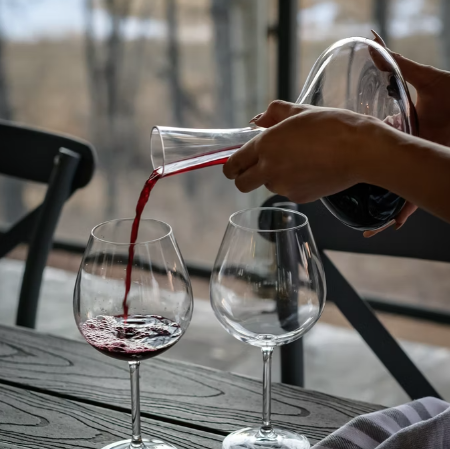Uncategorized
How and When to Use a Decanter
There’s a certain level of mystery when it comes to decanting. What wines should be decanted? How do you successfully decant? Is it necessary?
Although it may seem like decanting first evolved in high-end restaurants, wine vessels date back thousands of years. These vessels were made from bronze, silver, gold, and even blown glass. By the 17th century, it was customary to pour wine from its bottle into a jug or other container before serving. By the 18th century, decanting became a tradition in England. Today, we know more than ever about the properties of wine — and decanting plays on that knowledge.
Whether you recently received a decanter as a gift or have had one for years, collecting dust, a little insight into decanting 101 can transform your wine tasting experience.
This guide covers everything you need to know about decanting.
Why Decant Your Wine?
When you decant wine, it can become the best possible version of itself.
Decanting offers two primary benefits.
- First, it aerates the wine, encouraging a more vibrant aroma and flavor profile upon serving. Carbon dioxide is the main preservative component in wine, integrated during fermentation. When you pour wine into a decanter, particularly younger wines, oxygen exposure helps eliminate carbon dioxide. The wine will then mature and have less of a tannic taste. When decanting older wines, you will elevate the primary and secondary flavors.
- Secondly, if you have an older red wine or vintage port, this process helps wine separate from sediment. These wines produce sediment as they age (white wines rarely do). This sediment is the tannins bonding to color pigments. Although not harmful, this sediment can lead to bitter flavors and a gritty texture.
Dr. Gavin Sacks, a professor at Cornell University’s Department of Food Science, said, “Decanting dates back to alchemy when it was described as removing the liquid part of a mixture from solids.” So, separating clarified wine from the solids in the bottle was the initial concept behind decanting.
Decanting can also be a saving grace in the unfortunate event of a broken cork. The decanting process also adds to the overall wine-drinking experience. For many, that’s what it’s all about.
Recommended reading: How Long Does Wine Last Once It’s Been Opened?
How to Decant Wine
Typically, wine is stored on its side. If you plan to open a bottle that potentially has sediment in it, allow the wine to stand upright for 24+ hours to allow that sediment to settle. If you’re pulling a bottle from a horizontal storage unit, some recommend allowing the bottle to sit vertically for a couple of days. However, even a couple of hours is better than nothing.
If a bottle of red is five to ten years old, it’s safe to assume that there will be some sediment.
How you use a decanter will depend on the type of wine you’re decanting.
- Regular decanting — When you think of decanting, this is what likely comes to mind. This process involves pouring wine slowly and steadily into a decanter. Once you reach the bottom half of the bottle, pour even more slowly, stopping as soon as you see sediment in the neck of the bottle. Some people will hold a light beneath the neck of the bottle to more easily assess the wine’s clarity. To avoid too much sediment disturbance, hold the bottle below an angle of 45 degrees. Use this method for mature wines.
- Shock decanting — Also known as quick splash decanting, shock decanting is when you tip a bottle vertically, allowing gravity to force the wine into a decanter. In this case, the wine hits with greater force, naturally splashing and swirling around. This method is similar to aeration. The goal here is to expose the wine to oxygen vigorously. This method does not address sediment, which is why it’s best for young, tannic red wines — typically those that have been aging for less than two years.
How long you decant will depend on the wine. For example, many light-bodied wines, such as Grenache, Pinot Noir, and Zinfandel, only need 20-30 minutes. A medium-bodied wine, such as a Merlot or Malbec, can be decanted for 20 minutes to an hour. Finally, full-bodied reds, such as Cabernet Sauvignon or Nebbiolo, may not fully develop until decanted for one to two hours.
Additional Decanting Tips
- Sediment will not always be chunky. If you see what looks like specks of dust in the neck of the bottle or your wine becomes cloudy, stop pouring. You can then discard the remaining ounce, as it will be full of sediment.
- If a wine is particularly old or fragile, such as those 15+ years old), it should only be decanted 30 minutes or so before you drink it. A younger, full-bodied wine can be decanted for an hour or more before you serve it.
- It is not uncommon for certain wines to be decanted for hours before tasting. However, this increases the risk that your wine will become oxidized. Decanting for hours is only recommended if you’re very familiar with how the wine you’re decanting tends to age and evolve.
- Speaking of this risk, you can over-decant wine. In this case, white wines can lose their fruity aromas, and old vintages can decay. You typically only need to decant white wines or rosés if they smell off upon opening. For example, you may smell rotten eggs or burnt rubber because the aromatic compounds have gone too long without oxygen. Decanting for 15 minutes should allow the fruity scents to return.
- If you don’t have a decanter handy, swish your wine around in a glass. Doing so will allow the wine to breathe and open up.
- Although decanting is most often associated with red wines, this process is less about the color of wine and more about the structure and age.
Ready to experiment with your decanter? Whether you’re hosting a wine tasting event or are planning a special night in for you and your partner, check out Sweet Oaks wine.
More great resources:



